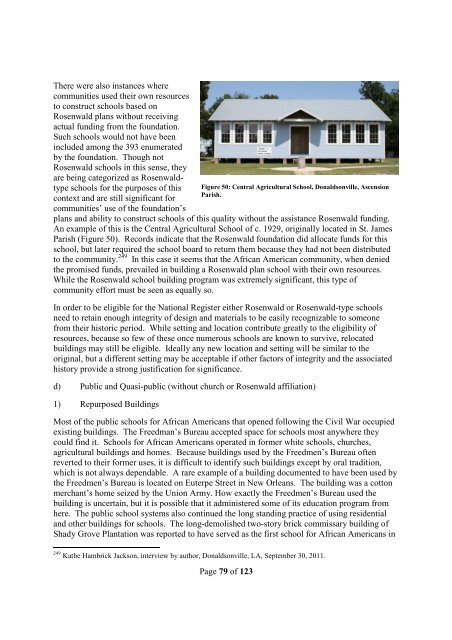The African American Experience in Louisiana
The_African_American_Experience_in_Louisiana
The_African_American_Experience_in_Louisiana
- No tags were found...
Create successful ePaper yourself
Turn your PDF publications into a flip-book with our unique Google optimized e-Paper software.
<strong>The</strong>re were also <strong>in</strong>stances where<br />
communities used their own resources<br />
to construct schools based on<br />
Rosenwald plans without receiv<strong>in</strong>g<br />
actual fund<strong>in</strong>g from the foundation.<br />
Such schools would not have been<br />
<strong>in</strong>cluded among the 393 enumerated<br />
by the foundation. Though not<br />
Rosenwald schools <strong>in</strong> this sense, they<br />
are be<strong>in</strong>g categorized as Rosenwaldtype<br />
schools for the purposes of this<br />
context and are still significant for<br />
communities’ use of the foundation’s<br />
plans and ability to construct schools of this quality without the assistance Rosenwald fund<strong>in</strong>g.<br />
An example of this is the Central Agricultural School of c. 1929, orig<strong>in</strong>ally located <strong>in</strong> St. James<br />
Parish (Figure 50). Records <strong>in</strong>dicate that the Rosenwald foundation did allocate funds for this<br />
school, but later required the school board to return them because they had not been distributed<br />
to the community. 249 In this case it seems that the <strong>African</strong> <strong>American</strong> community, when denied<br />
the promised funds, prevailed <strong>in</strong> build<strong>in</strong>g a Rosenwald plan school with their own resources.<br />
While the Rosenwald school build<strong>in</strong>g program was extremely significant, this type of<br />
community effort must be seen as equally so.<br />
In order to be eligible for the National Register either Rosenwald or Rosenwald-type schools<br />
need to reta<strong>in</strong> enough <strong>in</strong>tegrity of design and materials to be easily recognizable to someone<br />
from their historic period. While sett<strong>in</strong>g and location contribute greatly to the eligibility of<br />
resources, because so few of these once numerous schools are known to survive, relocated<br />
build<strong>in</strong>gs may still be eligible. Ideally any new location and sett<strong>in</strong>g will be similar to the<br />
orig<strong>in</strong>al, but a different sett<strong>in</strong>g may be acceptable if other factors of <strong>in</strong>tegrity and the associated<br />
history provide a strong justification for significance.<br />
d) Public and Quasi-public (without church or Rosenwald affiliation)<br />
1) Repurposed Build<strong>in</strong>gs<br />
Figure 50: Central Agricultural School, Donaldsonville, Ascension<br />
Parish.<br />
Most of the public schools for <strong>African</strong> <strong>American</strong>s that opened follow<strong>in</strong>g the Civil War occupied<br />
exist<strong>in</strong>g build<strong>in</strong>gs. <strong>The</strong> Freedman’s Bureau accepted space for schools most anywhere they<br />
could f<strong>in</strong>d it. Schools for <strong>African</strong> <strong>American</strong>s operated <strong>in</strong> former white schools, churches,<br />
agricultural build<strong>in</strong>gs and homes. Because build<strong>in</strong>gs used by the Freedmen’s Bureau often<br />
reverted to their former uses, it is difficult to identify such build<strong>in</strong>gs except by oral tradition,<br />
which is not always dependable. A rare example of a build<strong>in</strong>g documented to have been used by<br />
the Freedmen’s Bureau is located on Euterpe Street <strong>in</strong> New Orleans. <strong>The</strong> build<strong>in</strong>g was a cotton<br />
merchant’s home seized by the Union Army. How exactly the Freedmen’s Bureau used the<br />
build<strong>in</strong>g is uncerta<strong>in</strong>, but it is possible that it adm<strong>in</strong>istered some of its education program from<br />
here. <strong>The</strong> public school systems also cont<strong>in</strong>ued the long stand<strong>in</strong>g practice of us<strong>in</strong>g residential<br />
and other build<strong>in</strong>gs for schools. <strong>The</strong> long-demolished two-story brick commissary build<strong>in</strong>g of<br />
Shady Grove Plantation was reported to have served as the first school for <strong>African</strong> <strong>American</strong>s <strong>in</strong><br />
249 Kathe Hambrick Jackson, <strong>in</strong>terview by author, Donaldsonville, LA, September 30, 2011.<br />
Page 79 of 123


